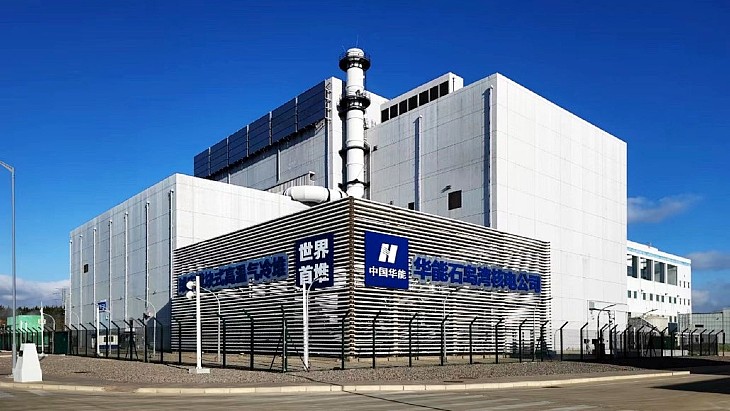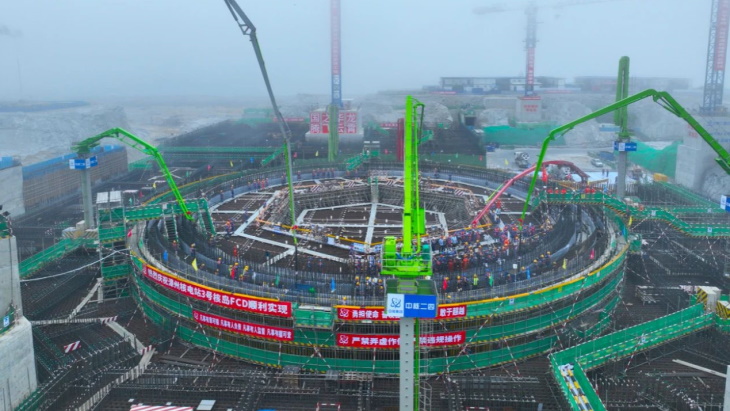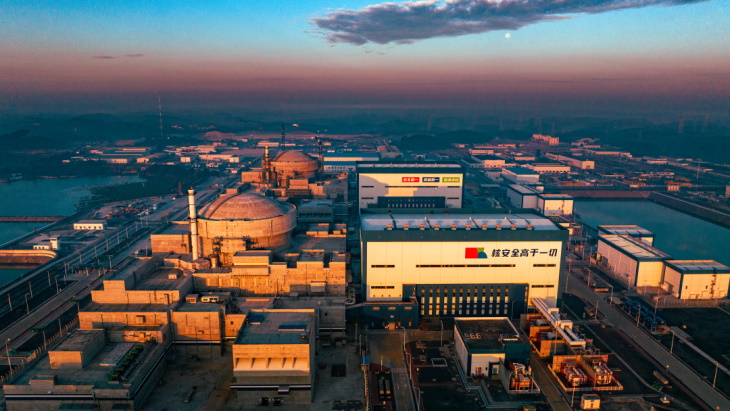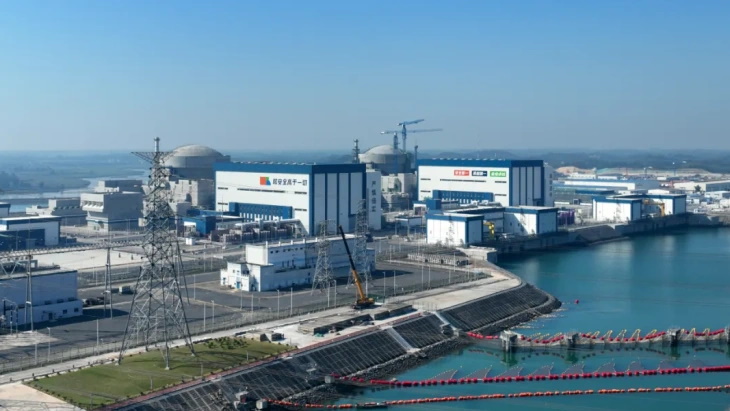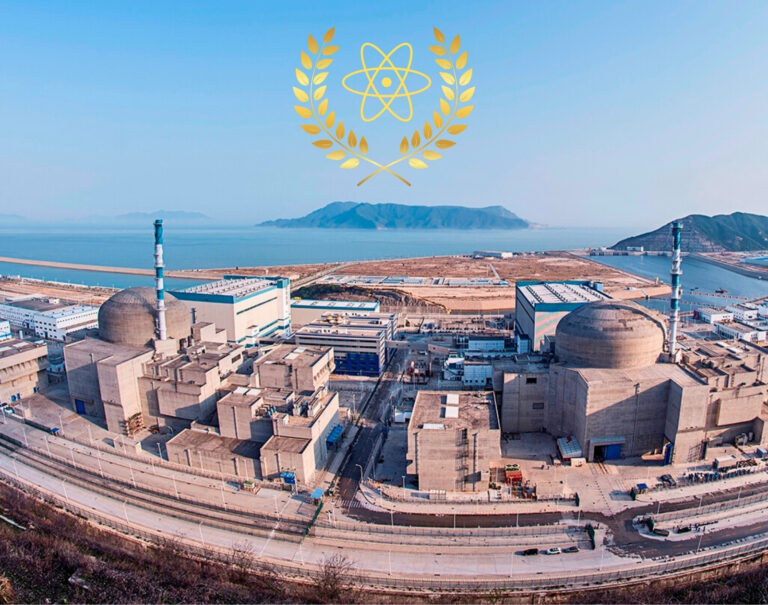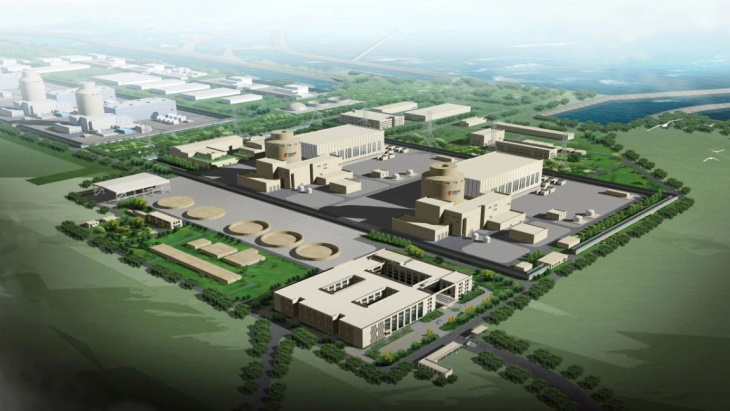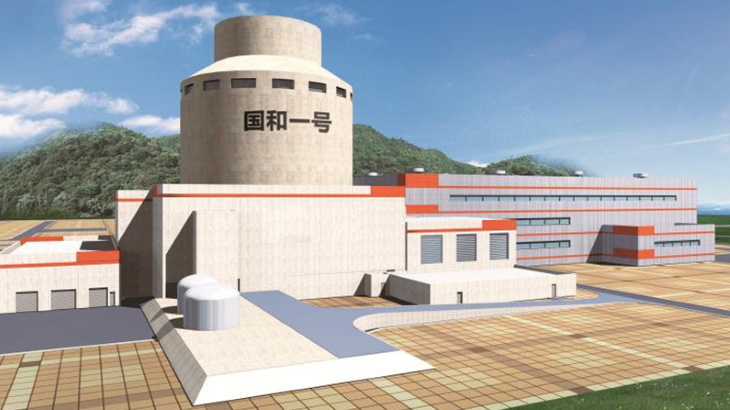https://www.world-nuclear-news.org/Arti ... -operationChina's demonstration HTR-PM enters commercial operation
06 December 2023
The world’s first modular high temperature gas-cooled reactor nuclear power plant has entered commercial operation, China’s National Energy Administration has announced.
The nuclear island of HTR-PM Demo (Image: Tsinghua University)
It follows a successful 168-hour demonstration run for the High Temperature Gas-Cooled Reactor - Pebble-bed Module (HTR-PM) in Shidao Bay (also known as Shidaowan), in Shandong Province, which is currently operating at 2×200 MWt power.
The HTR-PM features two small reactors (each of 250 MWt) that drive a single 210 MWe steam turbine. It uses helium as coolant and graphite as the moderator. Each reactor is loaded with more than 400,000 spherical fuel elements (‘pebbles’), each 60 mm in diameter and containing 7 g of fuel enriched to 8.5%. Each pebble has an outer layer of graphite and contains some 12,000 four-layer ceramic-coated fuel particles dispersed in a graphite matrix. The fuel has high inherent safety characteristics, and has been shown to remain intact and to continue to contain radioactivity at temperatures up to 1620°C - far higher than the temperatures that would be encountered even in extreme accident situations, according to the China Nuclear Energy Association.
First concrete for the demonstration project was poured on December 2012, with the operating permit granted in August 2021 and the plant connected to the grid in December 2021. The plant has more than 2200 sets of first-of-a-kind equipment, including more than 660 sets of innovative equipment. The supporting fuel element production line has the largest production capacity in the world.
The project is a collaborative effort involving Tsinghua University as a technical leader, responsible for research and development and main components and systems design, with China Huaneng Group as the owner and operator of the plant, and China National Nuclear Coorporation as the engineering, procurement, and construction contractor and fuel manufacturer. Professor Zuoyi Zhang, director of the Institute of Nuclear and New Energy Technology at Tsinghua University, is the chief scientist and chief engineer for the project.
HTR-PM is a Generation IV nuclear energy technology and a small modular reactor. Two safety demonstration tests were conducted on the reactor modules, each at a power of 200 MWt, on 13 August and 1 September, respectively.
A Tsinghua spokesperson said: "The normal energy transfer driven by power was stopped during the tests. The measured nuclear power and temperatures within the different reactor structures, described how the reactors were naturally cooled down, without intervention of humans or emergency core cooling systems. The tests confirmed that commercial-scale reactors could be cooled down naturally without emergency core cooling systems for the first time in the world. It is the so-called inherently safe reactor.
"The major purpose of HTR-PM is to co-generate high temperature steam up to 500℃ and electricity. It is cost effective currently in the Chinese market to supply steam and electricity for the petrochemical industry to substitute the burning of natural gas and coal. This breakthrough technology is recognised to play a positive role in optimising energy structure and achieving China's 'dual carbon' goal. Several commercial projects are under preparation in China."
China's National Energy Administration, in announcing the start of commercial operation, said: "The commissioning of the demonstration project is of great significance and has a positive impact on promoting the safe development of nuclear power in our country and improving our country's nuclear power power scientific and technological innovation capabilities."
In an interview last year for World Nuclear Association's World Nuclear Performance Report 2022, Lu Hua Quan, chairman of the Nuclear Research Institute, Huaneng Company, explained: "HTRs have the highest operating temperatures of all existing reactor types, and are also the only reactors that can provide very high-temperature process heat." He said there was export potential, especially to countries and regions where freshwater resources were scarce, adding that "HTRs could in the future provide a source of high-quality high-temperature process heat for various industries, in particular those that are required to limit their carbon emissions".
The HTR-PM follows on from China's HTR-10, a 10 MWt high-temperature gas-cooled experimental reactor at Tsinghua University's Institute of Nuclear and New Energy Technology, which started up in 2000 and reached full power in 2003. Beyond the HTR-PM, China proposes a scaled-up version - HTR-PM600 - with one turbine rated at 650 MWe driven by six reactor modules.
Le nucléaire en Chine
Modérateurs : Rod, Modérateurs
- energy_isere
- Modérateur

- Messages : 101870
- Inscription : 24 avr. 2005, 21:26
- Localisation : Les JO de 68, c'était la
- Contact :
Re: Le nucléaire en Chine
suite du post au dessus. C'est donc un Pebble-bed Module reactor
- energy_isere
- Modérateur

- Messages : 101870
- Inscription : 24 avr. 2005, 21:26
- Localisation : Les JO de 68, c'était la
- Contact :
Re: Le nucléaire en Chine
voir l' entrée Wikipedia pour ce type de réacteur. https://fr.wikipedia.org/wiki/HTR-PM
et
et
https://www.nextbigfuture.com/2023/12/c ... ation.htmlChina’s Pebble Bed Reactor Finally Starts Commercial Operation
December 13, 2023 by Brian Wang
......................

- energy_isere
- Modérateur

- Messages : 101870
- Inscription : 24 avr. 2005, 21:26
- Localisation : Les JO de 68, c'était la
- Contact :
Re: Le nucléaire en Chine
lire https://www.revolution-energetique.com/ ... ometteuse/Nucléaire : voici le réacteur à « lit de boulets », une technologie hyper prometteuse
Un second réacteur modulaire avancé (AMR en anglais) de 4ᵉ génération refroidi par hélium a été mis en service en Chine. C’est une grande avancée technologique pour ce type de réacteur à haute température (HT), domaine dans lequel l’Allemagne était jadis pionnière. Il utilise la technologie à « lit de boulets », censée apporter sûreté, modularité et permettrait, au-delà de la production électrique, de fournir de la vapeur industrielle et du chauffage urbain bas-carbone. Mais comment fonctionne-t-elle ?
18 Déc 2023 Ugo PETRUZZI
..............................
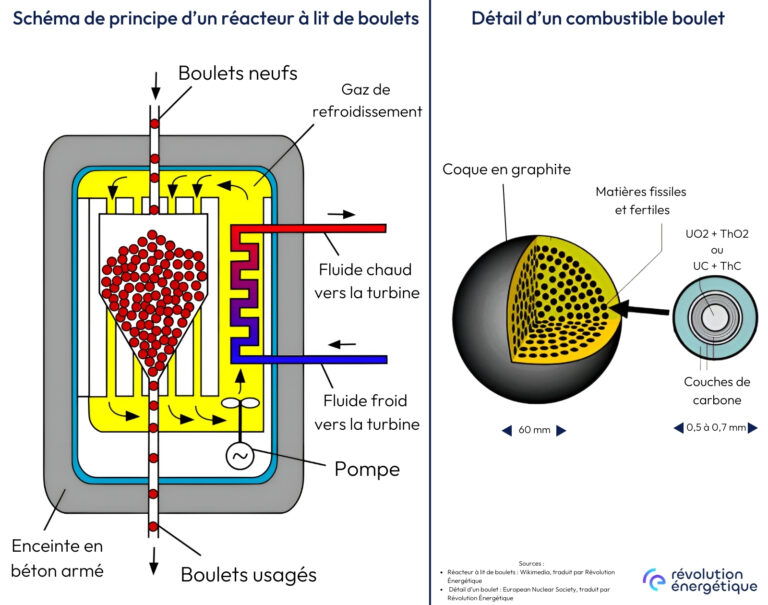
- GillesH38
- Hydrogène

- Messages : 30728
- Inscription : 10 sept. 2005, 17:07
- Localisation : Berceau de la Houille Blanche !
- Contact :
Re: Le nucléaire en Chine
de l'hélium liquide à 700 °C ? euh, il a du y avoir une confusion quelque part ....De symbole chimique He, l’hélium est un gaz dont les propriétés satisfaisantes de conduction et transfert de chaleur représentent un avantage : il n’interfère que peu avec les neutrons. C’est une qualité, car le fluide circule directement dans le cœur là où la réaction se produit. Grâce à sa propriété non métallique, il pourra monter plus haut en température : jusqu’à 700 °C lui sont imposés dans le cœur. À ce palier haut, il reste liquide sans changer de phase.
Zan, zendegi, azadi. Il parait que " je propage la haine du Hamas", mais aussi des juifs et d'Israël.
- energy_isere
- Modérateur

- Messages : 101870
- Inscription : 24 avr. 2005, 21:26
- Localisation : Les JO de 68, c'était la
- Contact :
Re: Le nucléaire en Chine
oui ca m'a choqué aussi de la part du rédacteur. C'est pas pour rien que ça s'appelle ''High Temperature Gas-Cooled Reactor''GillesH38 a écrit : ↑19 déc. 2023, 10:44de l'hélium liquide à 700 °C ? euh, il a du y avoir une confusion quelque part ....De symbole chimique He, l’hélium est un gaz dont les propriétés satisfaisantes de conduction et transfert de chaleur représentent un avantage : il n’interfère que peu avec les neutrons. C’est une qualité, car le fluide circule directement dans le cœur là où la réaction se produit. Grâce à sa propriété non métallique, il pourra monter plus haut en température : jusqu’à 700 °C lui sont imposés dans le cœur. À ce palier haut, il reste liquide sans changer de phase.
- energy_isere
- Modérateur

- Messages : 101870
- Inscription : 24 avr. 2005, 21:26
- Localisation : Les JO de 68, c'était la
- Contact :
Re: Le nucléaire en Chine
https://www.world-nuclear-news.org/Arti ... w-reactorsChina approves construction of four new reactors
03 January 2024
The construction of two Hualong One reactors at each of the Taipingling and Jinqimen sites was approved by China's State Council at a 29 December meeting. Meanwhile, various milestones have been reached in the construction of other Chinese units.
At the meeting of the Standing Committee of the State Council, chaired by Chinese Premier Li Qiang, approval was granted for units 3 and 4 at China General Nuclear's (CGN's) existing Taipingling nuclear power plant in Guangdong province, as well as units 1 and 2 at China National Nuclear Corporation's (CNNC's) new Jinqimen nuclear power plant in Zhejiang province.
The Taipingling plant will eventually have six Hualong One reactors. The construction of the first and second units began in 2019 and 2020, respectively. Unit 1 is scheduled to start up in 2025, with unit 2 following in 2026.
..................
- energy_isere
- Modérateur

- Messages : 101870
- Inscription : 24 avr. 2005, 21:26
- Localisation : Les JO de 68, c'était la
- Contact :
Re: Le nucléaire en Chine
suite de ce post du 17 sept 2022 http://www.oleocene.org/phpBB3/viewtopi ... 6#p2352766
https://www.world-nuclear-news.org/Arti ... hangzhou-pConstruction starts on second phase of Zhangzhou plant
22 February 2024
The first safety-related concrete has been poured for the nuclear island of unit 3 at the Zhangzhou nuclear power plant in Fujian province, China National Nuclear Corporation (CNNC) announced. It is the first of two Hualong One units planned as the second phase of the plant, which will eventually house six such reactors.
The first concrete is poured for the basemat of Zhangzhou unit 3 (Image: CNNC)
In May 2014, the local government gave approval for Phase I of the Zhangzhou plant, comprising two AP1000 units. The National Nuclear Safety Administration gave approval in December 2015 for the AP1000 units and confirmed site selection in October 2016. Construction of Phase I had originally been expected to start in May 2017. However, CNNC subsequently decided to use the HPR1000 (Hualong One) design instead. Two more Hualong One units are planned for Phase II of the plant and a further two proposed for Phase III.
Construction of Zhangzhou 1 began in October 2019, with that of unit 2 starting in September 2020. The units are scheduled to enter commercial operation in 2024 and 2025, respectively.
CNNC issued the environmental impact assessment for Zhangzhou units 3 and 4 in October 2020. In September 2022, China's State Council approved the construction of two Hualong One units as Phase II of the Zhangzhou plant.
CNNC has now announced that work on Phase II has commenced, with the pouring of first concrete for the nuclear island of unit 3 on 22 February.
The Zhangzhou project is owned by CNNC-Guodian Zhangzhou Energy Company, a joint venture between CNNC (51%) and China Guodian Corporation (49%).
The first two demonstration units of CNNC's version of the Hualong One design at the Fuqing plant in Fujian province have both already started up. Unit 5 entered commercial operation on 30 January 2021, with unit 6 following on 25 March 2022. Two Hualong One reactors have also been constructed as units 2 and 3 of the Karachi plant in Pakistan's Sindh province. These entered commercial operation in May 2021 and April 2022, respectively.
"At present, the first four units of Hualong One have been completed and put into operation, and the batch construction is progressing smoothly," CNNC said. "Among them, the Zhangzhou Nuclear Power Project is the starting point for the batch construction of Hualong One: unit 1 is expected to be put into operation in 2024; unit 2 is undergoing cold test-related preparations such as the installation of internal components of the reactor."
In addition to Zhangzhou units 1-3, CNNC is also building two Hualong One reactors as units 3 and 4 of the Changjiang plant, in Hainan province, construction of which began in March 2021 and December 2021, respectively.
Earlier this week, it also held a ground-breaking ceremony for Phase I of the Jinqimen plant in Zhejiang province, which will also feature two Hualong One reactors.
- energy_isere
- Modérateur

- Messages : 101870
- Inscription : 24 avr. 2005, 21:26
- Localisation : Les JO de 68, c'était la
- Contact :
Re: Le nucléaire en Chine
suite de ce post du 13 janvier 2023 http://www.oleocene.org/phpBB3/viewtopi ... 9#p2360889
aprés Fangchenggang 3 , Fangchenggang 4 :
aprés Fangchenggang 3 , Fangchenggang 4 :
https://www.world-nuclear-news.org/Arti ... ng-licenceFangchenggang 4 receives operating licence
28 February 2024
China's National Nuclear Safety Administration has granted an operating licence for unit 4 of the Fangchenggang nuclear power plant in China's Guangxi Autonomous Region. The unit is the second of two demonstration China General Nuclear-designed Hualong One (HPR1000) reactors at the site.
Fangchenggang units 3 and 4 (Image: CGN)
Obtaining the licence is "an important step towards high-quality production and commercial operation", China General Nuclear (CGN) said, adding that the loading of fuel into the 1180 MWe (gross) pressurised water reactor's core "is about to start".
First concrete was poured for the nuclear island of unit 3 - 39% owned by Guangxi Investment Group and 61% by CGN - in December 2015, while that for unit 4 was poured a year later. Unit 3 was originally expected to start up in 2019, with unit 4 scheduled to start up in 2020. Both their start-ups were subsequently postponed until 2022.
In January 2022, CGN announced that the start-up of Fangchenggang 3 and 4 had been put back again due to delays caused by the COVID-19 pandemic. Unit 3 achieved first criticality - a sustained chain reaction - on 27 December 2022 and was synchronised with the grid on 10 January 2023. It entered commercial operation on 25 March.
Hot functional testing of unit 4 began on 25 September last year. These tests involve increasing the temperature of the reactor coolant system and carrying out comprehensive tests to ensure that coolant circuits and safety systems are operating as they should. Carried out before the loading of nuclear fuel, such testing simulates the thermal working conditions of the power plant and verifies that nuclear island and conventional equipment and systems meet design requirements.
CGN has confirmed that unit 4 is expected to be put into operation in the first half of this year.
The Fangchenggang plant is planned to house six reactors. The first phase comprises two CPR-1000 units which were put into commercial operation in 2016.
The first two units of China National Nuclear Corporation's version of the Hualong One design at the Fuqing plant in Fujian province have both already started up. Unit 5 entered commercial operation on 30 January 2021, with unit 6 following on 25 March 2022.
- energy_isere
- Modérateur

- Messages : 101870
- Inscription : 24 avr. 2005, 21:26
- Localisation : Les JO de 68, c'était la
- Contact :
Re: Le nucléaire en Chine
https://www.world-nuclear-news.org/Arti ... ying-powerNew Chinese reactor begins supplying power
11 April 2024
Fangchenggang unit 4 - the second demonstration Hualong One (HPR1000) reactor at the site in China's Guangxi Autonomous Region - has been connected to the grid, China General Nuclear (CGN) announced.
The company said the 1180 MWe (gross) pressurised water reactor was successfully connected to the grid at 8.29pm on 9 April, "marking that the unit has the power generation capability and has taken another key step towards the goal of commercial operation".
CGN noted that a series of subsequent tests will be carried out to further verify the various performances of the unit with commercial operating conditions. It said the reactor is expected to be put into "high-quality production" in the first half of this year.
First concrete was poured for the nuclear island of Fangchenggang unit 3 - 39% owned by Guangxi Investment Group and 61% by CGN - in December 2015, while that for unit 4 was poured a year later. Unit 3 was originally expected to start up in 2019, with unit 4 scheduled to start up in 2020. Both their start-ups were subsequently postponed until 2022.
However, in January 2022, CGN announced that the start-up of Fangchenggang 3 and 4 had been put back again due to delays caused by the COVID-19 pandemic. Unit 3 achieved first criticality - a sustained chain reaction - on 27 December 2022 and was synchronised with the grid on 10 January 2023. It entered commercial operation on 25 March.
China's National Nuclear Safety Administration (NNSA) granted CGN an operating licence for Fangchenggang 4 on 27 February, allowing the loading of fuel into the reactor's core to begin. The fuel loading process was completed on 2 March. The reactor reached first criticality on 3 April.
The Fangchenggang plant is planned to house six reactors. The first phase comprises two CPR-1000 units which were put into commercial operation in 2016. Units 5 and 6 are expected to feature Hualong One reactors.
The first two units of China National Nuclear Corporation's version of the Hualong One design at the Fuqing plant in Fujian province have both already started up. Unit 5 entered commercial operation on 30 January 2021, with unit 6 following on 25 March 2022.
- energy_isere
- Modérateur

- Messages : 101870
- Inscription : 24 avr. 2005, 21:26
- Localisation : Les JO de 68, c'était la
- Contact :
Re: Le nucléaire en Chine
suite de ce post du 8 novembre 2023 http://www.oleocene.org/phpBB3/viewtopi ... 3#p2379783
https://www.world-nuclear-news.org/Arti ... ns-at-ChinDigital control system installation begins at Chinese SMR
11 April 2024
Installation of the digital control system has begun at the ACP100 small modular reactor demonstration project at the Changjiang site on China's island province of Hainan, China National Nuclear Corporation (CNNC) has announced.
............................
CNNC announced in July 2019 the launch of a project to construct an ACP100 reactor at Changjiang. The site is already home to two operating CNP600 pressurised water reactors (PWRs), while the construction of the two Hualong One units began in March and December 2021. Both those units are due to enter commercial operation by the end of 2026.
First concrete for the ACP100 was poured on 13 July 2021, with a planned total construction period of 58 months. Equipment installation work commenced in December 2022 and the main internal structure of the reactor building was completed in March 2023.
Under development since 2010, the 125 MWe ACP100 integrated PWR's preliminary design was completed in 2014. In 2016, the design became the first SMR to pass a safety review by the International Atomic Energy Agency.
Once completed, the Changjiang ACP100 reactor will be capable of producing 1 billion kilowatt-hours of electricity annually, enough to meet the needs of 526,000 households. The reactor is designed for electricity production, heating, steam production or seawater desalination.
The project at Changjiang involves a joint venture of three main companies: CNNC subsidiary China National Nuclear Power as owner and operator; the Nuclear Power Institute of China as the reactor designer; and China Nuclear Power Engineering Group being responsible for plant construction.
- energy_isere
- Modérateur

- Messages : 101870
- Inscription : 24 avr. 2005, 21:26
- Localisation : Les JO de 68, c'était la
- Contact :
Re: Le nucléaire en Chine
https://www.revolution-energetique.com/ ... lhumanite/Nouveau record : voici le réacteur nucléaire le plus productif de l’histoire de l’humanité
Jamais un réacteur nucléaire avait produit autant d’électricité en une seule année. Le réacteur n°2 de la centrale de Taishan (Chine), de type EPR, a battu un record absolu de production. En 2023, celui-ci a été capable de produire 12,8 TWh d’électricité grâce à un excellent facteur de charge. Ce record pourra-t-il être battu, dans les années à venir, par Flamanville, l’unique EPR français ?
Kevin CHAMPEAU 21 Mai 2024
La centrale nucléaire de Taishan en Chine / Image : AIEA, modifiée par RE.
Décidément, le réacteur n°2 de la centrale de Taishan multiplie les records. L’EPR a battu, en 2023, le record de production d’électricité par un réacteur nucléaire avec 12 884,1 GWh. Un record qui lui appartenait déjà, puisqu’il était parvenu à produire 12 454,8 GWh d’électricité en 2020, dès sa deuxième année d’exploitation. Ce record de production a été rendu possible grâce à un facteur de charge remarquable de 88,6 %.
Avec ses performances, Taishan 2 apporte une lueur d’espoir la filière des EPR dont les difficultés se sont enchaînées avant même le début du chantier du premier EPR, en août 2005. Les différents chantiers internationaux ont cumulé les incidents, engendrant un retard de 9 ans pour le réacteur finlandais de Olkiluoto 3, et 12 ans pour Flamanville. Au Royaume-Uni, les deux réacteurs en construction de la centrale Hinkley Point affichent déjà un retard de 4 ans sur le planning initial.
Flamanville pourra-t-il faire mieux ?
Pour l’heure, difficile de savoir si ce record pourra être battu. Les différents EPR construits à travers le monde affichent tous une puissance quasiment équivalente. Ainsi, dans les années à venir, les records de production annuels devraient principalement se jouer sur les conditions opérationnelles de chaque réacteur, et sur leur gestion. À titre d’exemple, Taishan 1, mis en service seulement quelques mois avec Taishan 2, n’a jamais dépassé les 12 TWh de production à cause de nombreuses défaillances, l’empêchant de fonctionner à pleine puissance sur de longues périodes. Depuis sa mise en service, il affiche un facteur de charge de seulement 48,6 % contre 77,7 % pour Taishan 2. Du côté de Flamanville, espérons que la mise en service signe la fin des difficultés, et puisse fonctionner avec un facteur de charge élevé. Toutefois, un premier arrêt pour maintenance prévu fin 2025 l’empêchera de revendiquer un facteur de charge élevé lors des premières années de fonctionnement.
- energy_isere
- Modérateur

- Messages : 101870
- Inscription : 24 avr. 2005, 21:26
- Localisation : Les JO de 68, c'était la
- Contact :
Re: Le nucléaire en Chine
Première mondiale en Chine, de la vapeur générée par un réacteur nucléaire est envoyée sur 23 km de tuyaux pour utilisation dans une usine pétrochimique.
https://www.world-nuclear-news.org/Arti ... -commissioChinese industrial nuclear steam project commissioned
20 June 2024
China's first industrial-use nuclear energy steam supply project, at the Tianwan nuclear power plant in China's Jiangsu province, has entered operation following commissioning tests. The project will supply steam to a nearby petrochemical plant.
(Image: CNNC)
The project - known as Heqi-1 - was jointly developed by China National Nuclear Corporation (CNNC) subsidiary Jiangsu Nuclear Power Company and the Lianyungang Petrochemical Industry Base in the Xuwei New District of Lianyungang City.
In the project, steam will be extracted from the secondary circuits of units 3 and 4 of the Tianwan plant, two Russian-supplied VVER-1000 units. After passing through multi-stage heat exchange, the steam will be transported via an insulated above-ground pipeline to the Lianyungang Petrochemical Industrial Base for industrial production and utilisation.
The construction of the pile foundation for the project began in February 2022, with the pouring of first concrete for the industrial steam facility taking place in May 2022.
The Tianwan plant is equipped with four steam conversion devices. The industrial superheated steam transmitted out of the nuclear power plant has a pressure of 1.8 MPa and a rated flow rate of 600 tonnes per hour.
The total length of the long-distance steam supply main line of the Tianwan nuclear power steam energy supply project is about 23 kilometres. The pipeline network extends from the Tianwan nuclear power plant to the Xuwei Petrochemical Industrial Park.
The facility is expected to supply 4.8 million tonnes of steam annually, which will reduce the burning of standard coal by 400,000 tonnes per year, and the equivalent emission reduction of 1.07 million tonnes of carbon dioxide, 184 tonnes of sulphur dioxide and 263 tonnes of nitrogen oxides.
CNNC said the start of operation of the steam project "marks that China's comprehensive utilisation of nuclear energy has expanded from single power generation and meeting urban residents' heating needs to the field of industrial steam supply". It added that the Heqi-1 project "is a model of clean steam supply for the national petrochemical industry".
- energy_isere
- Modérateur

- Messages : 101870
- Inscription : 24 avr. 2005, 21:26
- Localisation : Les JO de 68, c'était la
- Contact :
Re: Le nucléaire en Chine
https://www.connaissancedesenergies.org ... res-240820Pékin donne le feu vert à 11 nouveaux réacteurs nucléaires
AFP le 20 août 2024
La Chine a donné cette semaine le feu vert à 11 nouveaux réacteurs nucléaires répartis sur cinq sites, selon l'agence d'Etat Chine nouvelle, poursuivant ainsi ses efforts pour réduire ses émissions de gaz à effet de serre.
L'approbation a été donnée lundi lors d'une réunion du Conseil d'Etat (gouvernement) présidée par le Premier ministre Li Qiang, a précisé l'agence de presse officielle.
L'entreprise China National Nuclear Power a indiqué avoir reçu le feu vert pour trois réacteurs, tandis qu'un autre groupe, State Power Investment Corp, a dit être autorisé pour deux autres.
CGN Power Co, la filiale cotée en Bourse de la société d'Etat China General Nuclear Power Corp, a annoncé dans un communiqué adressé à la Bourse de Hong Kong avoir obtenu l'approbation pour six réacteurs répartis sur trois sites.
Les nouveaux réacteurs seront installés dans les provinces côtières du Jiangsu, Shandong et du Zhejiang (est), dans la province manufacturière du Guangdong (sud) et au Guangxi voisin, selon le média d'Etat spécialisé China Energy News.
Le média économique chinois Jiemian a précisé que l'investissement total pour les 11 réacteurs devrait dépasser les 220 milliards de yuans (27,8 milliards d'euros) et que leur construction prendra environ cinq ans.
Le pays compte actuellement 56 réacteurs en opération, soit autant que la France, selon l'Association nucléaire mondiale (ANM). Les Etats-Unis, qui en disposent de 94, sont le premier parc nucléaire mondial.
Le géant asiatique est le pays qui possède le plus grand nombre de réacteurs en construction.
La Chine est le premier émetteur de gaz à effet de serre, responsables selon les scientifiques du changement climatique.
Elle s'est engagée à atteindre un pic d'émissions de CO2 d'ici à 2030 puis la neutralité carbone d'ici 2060, mais elle a récemment donné de nombreux feux verts à des centrales à charbon, faisant douter de sa capacité à remplir ses objectifs.
- energy_isere
- Modérateur

- Messages : 101870
- Inscription : 24 avr. 2005, 21:26
- Localisation : Les JO de 68, c'était la
- Contact :
Re: Le nucléaire en Chine
https://www.connaissancedesenergies.org ... ais-240825Pourquoi les réacteurs nucléaires chinois coûtent moins cher que les français
AFP le 25 août 2024
La Chine poursuit sa course à l'atome à un rythme sans équivalent dans le monde et à un coût bien moins élevé qu'ailleurs, grâce à une industrie mature et un accès au capital privilégié, deux éléments dont le nucléaire français est pour l'instant dépourvu.
Pékin a donné mardi le feu vert à 11 nouveaux réacteurs, pour un investissement de moins de 28 milliards d'euros, selon le média chinois Jiemian.
En comparaison, le coût prévisionnel du programme de construction des six nouveaux réacteurs (EPR) commandés par l'Etat français est de 67,4 milliards d'euros, selon les Echos.
Ramenés à leur puissance - 1,1 gigawatt (GW) pour la plupart d'entre eux, des Hualong One et des CAP1000 selon WNN, organe de la World Nuclear Association - les 11 réacteurs chinois ont un coût environ trois fois inférieur aux futurs EPR, sans prendre en compte le coût du financement.
- La Chine en vitesse de croisière -
Un écart de prix d'abord dû aux économies d'échelle que réalise la Chine, où 27 réacteurs sont actuellement en construction, selon l'Agence internationale de l'énergie atomique.
Pékin bénéficie d'un "effet de série" et d'un "effet d'apprentissage", explique l'ingénieur Maxence Cordiez, expert associé à l'Institut Montaigne: les pièces commandées aux fournisseurs coûtent moins cher, les processus sont plus efficaces et la construction plus rapide.
"Pour faire moins cher en Europe, il faut des programmes industriels cadencés, avec des conceptions identiques", affirme Valérie Faudon, déléguée générale de la Société française d'énergie nucléaire (SFEN).
Au-delà du coût de construction, la Chine profite également d'un accès privilégié au capital.
La construction de réacteurs nucléaires nécessite de dépenser beaucoup d'argent, sans pour autant dégager de recettes: il faut donc emprunter.
Or pour les investisseurs, financer une centrale est considéré comme "risqué", en raison "du risque régulatoire" et du "risque politique" que comporte ce type de chantier, explique François Lévêque, professeur d'économie à Mines ParisTech.
D'une part, les agences de sûreté peuvent intervenir durant le chantier et le retarder. D'autre part, les possibles changements de majorité politique rendent plus incertains ces projets de long terme.
- Faramineux coût du capital -
"Les prêteurs demandent donc un taux relativement élevé", indique François Lévêque, là où en Chine, les projets nucléaires "ne sont pas plombés par tout cela: le coût du capital est très faible. C'est l'Etat chinois qui paie".
Selon le taux déterminé, le coût de financement d'une centrale peut varier de plusieurs milliards d'euros.
Pour faire baisser le coût du capital, les Etats peuvent s'impliquer en apportant des garanties ou du capital.
"Plus vous avez un engagement de l'Etat, plus le risque financier baisse, et vous faites baisser énormément les coûts des projets nucléaires", explique Nicolas Goldberg, expert chez Colombus Consulting.
Un rapport de la Cour des comptes britannique (NAO) sur le chantier nucléaire de Hinkley Point a par exemple fustigé le financement de la centrale construite par EDF, notant qu'une participation partielle de l'Etat britannique aurait pu faire baisser le prix du mégawattheure de près de 30%.
L'enjeu des aides d'Etat est donc au coeur de l'avenir de la filière nucléaire en Europe. "C'est une question de choix politiques et de choix de régulation", affirme Nicolas Goldberg.
La décision du Parlement européen en 2022 d'inclure le nucléaire dans la taxonomie verte vise justement à faire baisser le coût du capital des projets nucléaires.
Mais les garanties d'Etat n'empêchent pas l'atome de coûter extrêmement cher en cas de gros retards de livraison, à l'instar de l'EPR de Flamanville, dont la facture s'élève après 12 ans de retard à plus de 19 milliards d'euros, dont 3 milliards d'euros de "surcoût de financement", selon la Cour des Comptes.
De son côté, la Chine, qui déclare construire ses centrales en 56 mois, ambitionne de les exporter bon marché.
L'un de ses réacteurs, le Hualong-1, est déjà commercialisé à l'étranger (Pakistan, Argentine), sans jamais, pour l'instant, avoir trouvé preneur en Europe.
Mais "si la Chine commence à proposer du nucléaire à prix très compétitif, certains pays de l'Est, qui n'ont pas une industrie nucléaire propre et veulent se défaire du russe Rosatom, pourraient être tentés", estime Nicolas Goldberg.
- energy_isere
- Modérateur

- Messages : 101870
- Inscription : 24 avr. 2005, 21:26
- Localisation : Les JO de 68, c'était la
- Contact :
Re: Le nucléaire en Chine
https://www.world-nuclear-news.org/arti ... ying-powerChina's first CAP1400 begins supplying power
4 November 2024
The first of two demonstration Guohe One (CAP1400) reactors at Huaneng Group's Shidaowan site in China's Shandong province has been connected to the grid. The 1400 MWe pressurised water reactor design is intended to be deployed in large numbers across the country, as well as for export.
An illustration of the CAP1400 demonstration project (Image: CNEA)
The CAP1400 is an enlarged version of the CAP1000 PWR developed from the Westinghouse AP1000, with consulting input from the USA-based company.
Research and development for Guohe One began in 2008. In December 2009, the State Nuclear Plant Demonstration Company – a 55-45% joint venture company by State Power Investment Corp (SPIC) and China Huaneng Group – was set up to build and operate two demonstration unit of the CAP1400 at Huaneng's Shidaowan site at Rongcheng. SPIC officially launched the CAP1400 reactor design in September 2020.
Construction of unit 1 started in June 2019 and unit 2 in April 2020. The reactor design is expected to take 56 months to build, with later units coming down to 50 months.
The National Nuclear Safety Administration issued an operating license for the first Guohe One demonstration reactor in late July this year.
Speaking at a press conference on 31 October, Dong Wancheng, deputy director of the Development Planning Department at the National Energy Administration (NEA), announced that the first CAP1400 unit at Shidaowan had been successfully connected to the grid.
The CAP1400 reactor design (Image: SPIC)
The reactor will now undergo gradual power ascension testing and trial operation verification before officially entering commercial operation.
"After it is put into operation, the annual power generation will be 11.4 billion kilowatt-hours, which can meet the electricity needs of more than 11 million residents and reduce greenhouse gas emissions by more than 9 million tonnes per year," NEA noted.
It added: "Since 2022, several CAP series third-generation nuclear power units under the State Power Investment Corporation have been approved to start construction, and this series of nuclear power models will usher in a peak period of construction in the next few years."
In May 2016, the CAP1400 design successfully passed the International Atomic Energy Agency's Generic Reactor Safety Review. This review is not a clearance process but a review of the quality of the safety documents identifying strengths, weaknesses and gaps. International use of the CAP1400 is still dependent on meeting country-specific standards and requirements, but passing the IAEA safety review will make this process easier.
